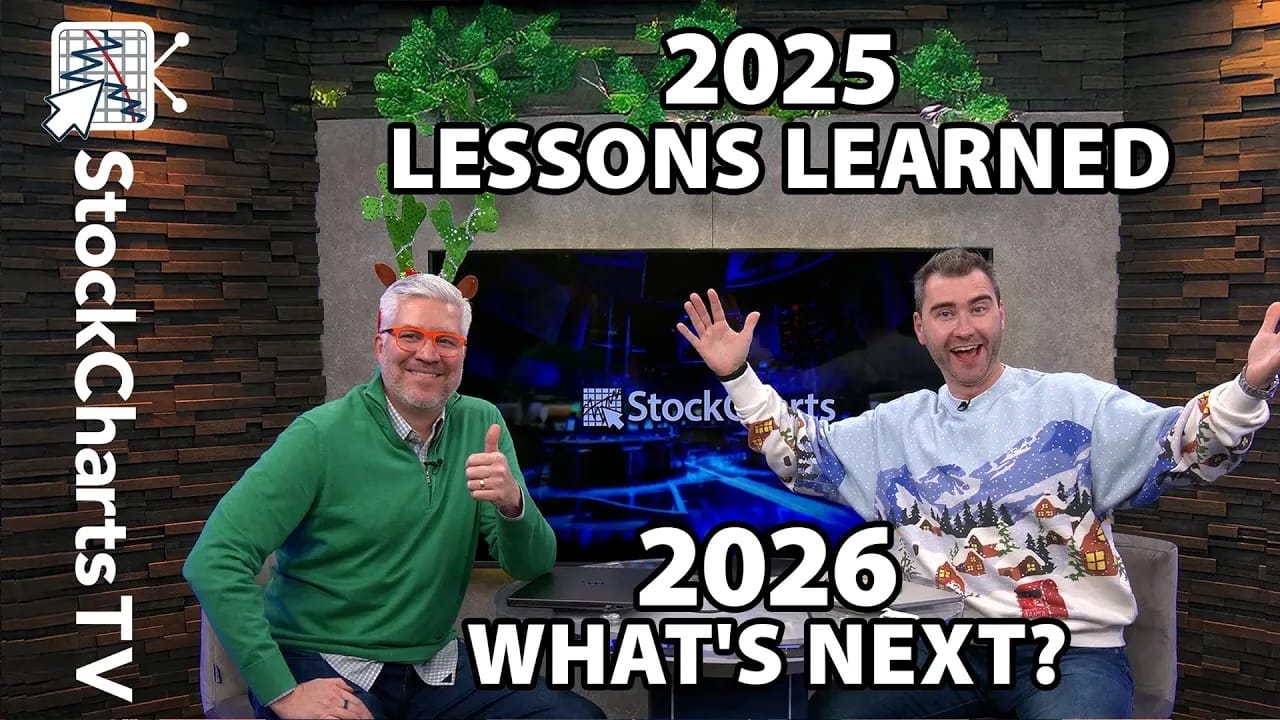SMALL-CAPS LEAD MARKET LOWER -- GAPS MARK RESISTANCE FOR QQQQ, SPY AND DIA -- FINANCIALS CONTINUE TO WEIGH OVERALL -- SEMIS BUILD ON SUPPORT BREAK -- RETAILERS DRAG DOWN CONSUMER DISCRETIONARY SECTOR
SMALL-CAPS LEAD MARKET LOWER... Link for todays video. Stocks moved broadly lower on Monday with small-caps leading the way. The Dow fell around 141 points to test the 10,000 mark at the close (-1.4%). The S&P 500 and Nasdaq were both down around 1.5%. The Russell 2000 ($RUT) out did them all by losing almost 2.5% on the day. Chart 1 shows the index bouncing off support with two long white candlesticks last week. In fact, the Russell 2000 ($RUT) was one of the best performing indices last week. This short bout of outperformance disappeared with todays sharp decline. On the price chart, the index is still testing potential support around 590. I call it potential support because the overall trend is down as prices move from the upper left of the chart to the lower right. With todays decline, the index established resistance at 620. At the very least, a convincing break above this level is needed to consider the support test successful and entertain thoughts of a double bottom. The indicator window shows the Commodity Channel Index (CCI) hovering around -100 (oversold). Even though the index became oversold numerous times, CCI is in bear mode as long as it remains in negative territory. Look for a break above +25 to put momentum back in bull mode. Why +25 and not just 0? Setting the bullish threshold just above the zero line may prevent a whipsaw.

(click to view a live version of this chart)
Chart 1
GAPS MARK RESISTANCE FOR QQQQ, SPY AND DIA... Charts 2 and 3 show the Nasdaq 100 ETF (QQQQ) and the Dow SPDR (DIA) with similar price patterns at work. While the Russell 2000 and Russell 2000 ETF (IWM) tested their July lows, these two held up better by holding above their July lows. Put another way, the Russell 2000 underperformed. QQQQ and DIA are both trying to firm around their 62% retracements. The August decline retraced around 62% of the July-August advance. Also notice that both ETFs formed falling channels or wedges over the last 3-4 weeks and last weeks gap turned into resistance. While a reversal at the 62% retracement is a possibility, the bearish case is solid as long as the channels fall and the gaps remain unfilled. Look for both to break above the orange resistance zones to reverse the August downtrends. Also look for CCI to break into positive territory to turn momentum bullish. As long as these gaps hold and CCI remains negative, the evidence favors the bears and further weakness.

(click to view a live version of this chart)
Chart 2

(click to view a live version of this chart)
Chart 3
Chart 4 shows the S&P 500 ETF (SPY) also meeting resistance from last weeks gap. The ETF surged above 106 on Friday, but met resistance from the gap and fell back below 106 on Monday. A falling channel or wedge formed over the last 3-4 weeks. Again, the downtrend is undeniable as long as last weeks gap remains unfilled. Should SPY surge above 107.10 to fill the gap and reverse the downtrend, a reaction low would form from last weeks lows. It would then be possible that an inverse head-and-shoulders pattern is taking shape. This pattern remains a big if because SPY is in a downtrend until proven otherwise. Now we know what to look for in the coming days or weeks. Lower prices are expected until a reversal.

(click to view a live version of this chart)
Chart 4
FINANCIALS CONTINUE TO WEIGH OVERALL... Financials led the market higher on Friday, but turned right around and led the market lower on Monday. Chart 5 shows the Financials SPDR (XLF) giving back almost all of Fridays gains with a sharp decline on Monday. XLF led all sectors with a 2.11% decline and closed below the July closing low. It is quite disconcerting to see the finance sector continue to lead the market lower and show relative weakness. Finance is still one of the biggest sectors and relative weakness is not good sign for the banking system. The price relative has been moving lower since April and shows no signs of a recovery. With todays decline, XLF established short-term resistance based on last weeks high. A recovery and break above 13.75 is needed to keep support from the July low alive. Chart 6 shows the Regional Bank SPDR (KRE) closing at its lowest level of 2010. Regional banks are even weaker than the finance sector, which is dominated by the big banks. Relative weakness in small and mid-cap financials is weighing on the Russell 2000.

(click to view a live version of this chart)
Chart 5

(click to view a live version of this chart)
Chart 6
SEMIS EXTEND SUPPORT BREAK WITH MORE WEAKNESS... The semiconductors are to technology what the finance sector is to the broader market. The broader market is not going far with finance showing relative weakness and the technology sector is not going far with semis showing relative weakness. Chart 7 shows the Semiconductors HOLDRS (SMH) breaking below support from the May-June-July-August lows. SMH bounced off the 25.5 area each of the last four months and broke below these lows with a sharp decline the last few days. John Murphy pointed out relative weakness in the Semiconductor Index ($SOX) on August 19th. SMH has followed suit with sharp declines in Intel (INTC), Texas Instruments (TXN) and Applied Materials (AMAT). The price relative shows the performance of SMH relative to the S&P 500 ETF with a ratio plot (SPY:SMH). Relative performance peaked in July and has been moving lower the last six weeks.

(click to view a live version of this chart)
Chart 7
RETAILERS DRAG DOWN CONSUMER DISCRETIONARY SECTOR... Retail stocks took a hit on Monday and renewed relative weakness is a concern for the broader market. According to many economists, retail spending drives 2/3 of GDP. With all this talk of a double dip and a slew of economic reports due this week, I will be watching the Retail SPDR (XRT) and the Consumer Discretionary SPDR (XLY) closely this week and next. Chart 8 shows the Retail SPDR (XRT) falling around 2.5% on Monday. Like the rest of the market, the ETF remains in a downswing over the last four weeks. XRT needs to break above 38 to reverse this downswing. The indicator window shows XRT relative to SPY. After underperforming in June-July, the price relative flattened out the last six weeks. However, a breakout remains elusive and a move above the August high is needed to show relative strength again. Chart 9 shows the Consumer Discretionary SPDR with similar characteristics. A break above 31 is needed to reverse the August downswing.

(click to view a live version of this chart)
Chart 8












